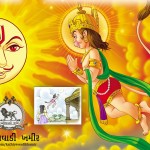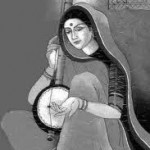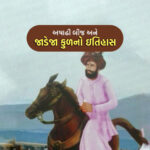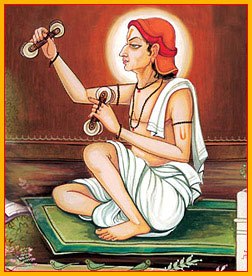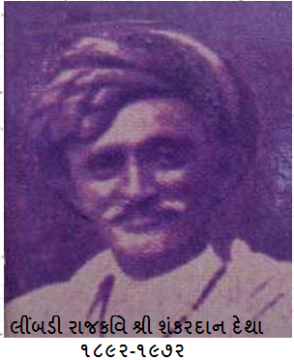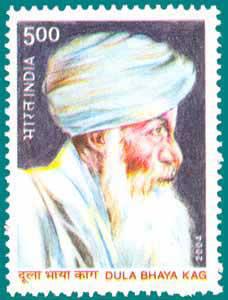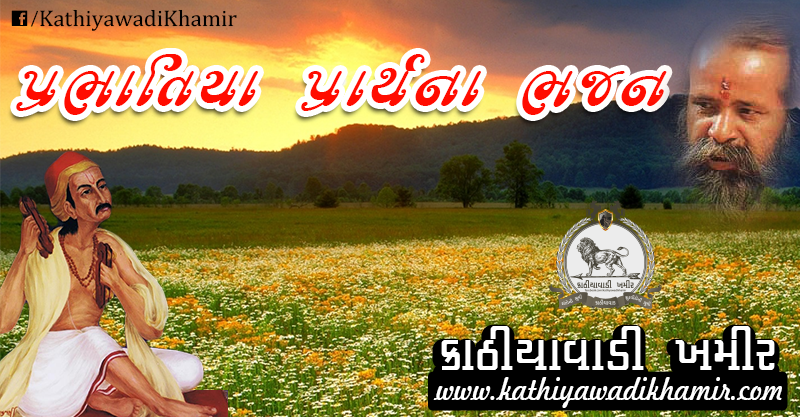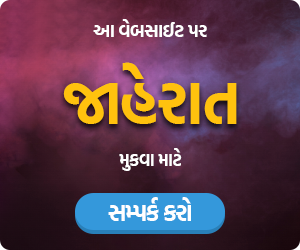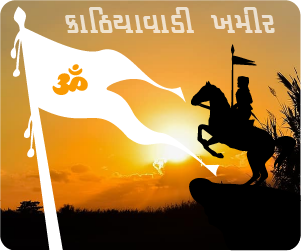ગુજરાતી ભાષાના આદિકવિનું બિરુદ મેળવનાર નરસિંહ મહેતા (૧૪૧૪–૧૪૮૦) માત્ર ગુજરાતના જ નહીં પરંતુ ભારતના ઉત્તમ સંત-કવિઓમાં અગ્રગણ્ય સ્થાન ધરાવે છે. વડનગરા બ્રાહ્મણની નાગર જ્ઞાતિમાં જન્મેલા નરસિંહ મહેતાની આર્થિક સ્થિતિ નબળી હતી. નાનપણમાં માતા-પિતાનું મૃત્યુ થતાં તેમણે ભાઇ-ભાભીને આશરે જીવવું પડયું. ભજન સિવાય તેમને કશામાં રસ પડતો ન હતો. ગૌરી સાથેના લગ્નથી તેમને ત્યાં પુત્ર શામળશા અને પુત્રી કુંવરબાઈનો જન્મ થયો.
પોતાની મસ્તીમાં મસ્ત રહેતા નરસિંહને ભાભીના મહેણાં અવારનવાર મળતાં. એક વાર મહેણું સહન ન થવાથી નરસિંહ મહેતા ઘર છોડી એકાંતમાં આવેલ ગોપીનાથ મહાદેવમાં ચાલ્યા ગયા. ત્યાં ઉપાસના કરવાથી મહાદેવજી પ્રગટ થયા અને એમને રાસલીલાનાં દર્શન કરાવ્યાં. શ્રીકૃષ્ણ-રાધાનાં દર્શન કર્યા ત્યારથી તેમને કૃષ્ણભક્તિની લગની લાગી. પોતાની અનુભૂતિઓને તેમણે શબ્દના માધ્યમ દ્વારા વહેતી કરી. એમણે આશરે ૧૫૦૦ થી વધારે પદો રચ્યાં જેમાં પુત્ર શામળશાનો વિવાહ, પુત્રી કુંવરબાઈનું મામેરું, હુંડીનો પ્રસંગ, હારનો પ્રસંગ, શ્રાદ્ધ, જેવા સ્વાનુભવાત્મક પ્રસંગો ઉપરાંત વસંતનાં પદો, હિંડોળાનાં પદો, કૃષ્ણભક્તિનાં પદો, સુદામાચરિત્ર વગેરેનો સમાવેશ થાય છે. તેમની સૌથી સુપ્રસિદ્ધ રચના વૈષ્ણવ જન, જે મહાત્મા ગાંધીને ખૂબ પ્રિય હતી, ભાગ્યે જ કોઈ અજાણ હશે.
સાંસારિક જીવનનો બોજ પણ ઈશ્વરને સમર્પિત કરનાર નરસિંહના જીવનમાં એવા અનેક પ્રસંગો બન્યા કે જેણે તેમની અનન્ય ભકિતનાં દર્શન કરાવ્યાં.
એમની દીકરી કુંવરબાઇના મામેરા વખતે વડસાસુએ લાંબુંલચ લિસ્ટ લખીને કુંવરબાઇના હાથમાં આપી દીધું. કુંવરબાઇ રડતાં-રડતાં પિતાજીની પાસે આવ્યાં ત્યારે નરસિંહ મહેતા એક જ વાકય બોલ્યા, ‘મારો કૃષ્ણ બેઠો છે પછી શાની ચિંતા.’ અને ભગવાન દ્વારિકાધીશે ખરેખર લિસ્ટમાં લખેલી બધી જ વસ્તુ તેમના આંગણે પહોંચાડી.
એક વાર એમના વેવાણે નાહવા માટે ગરમ પાણી આપ્યું ત્યારે નરસિંહ બોલ્યા, ‘થોડું ઠંડું પાણી હોય તો આપોને.’ ત્યારે વેવાણે મહેણું માર્યું, ‘તમે તો ભગવાનના ભગત છો તો વરસાદ વરસાવોને’ અને મહેતાજીએ હાથમાં કરતાલ લઇ એવો મલ્હાર ગાયો કે અચાનક વાતાવરણ પલટાઇ ગયું અને મૂશળધાર વરસાદ તૂટી પડયો.
જયારે એમના ઉપર ચોરીનો આરોપ આવ્યો ત્યારે ભગવાન દ્વારિકાધીશે મહેતાજીને નિર્દોષ સાબિત કરવા માટે ગળામાં હાર પહેરાવ્યો. આ જોઇને રાજા ચરણમાં ઝૂકી પડયો.
આ જ રીતે પિતાજીનું શ્રાદ્ધ કરવા માટે વેપારીઓ પાસેથી પૈસા લઇને શામળશા શેઠના નામે હૂંડી લખી આપી અને ભગવાન દ્વારિકાધીશે શામળશા શેઠનો વેશ ધરીને હૂંડીનાં બધાં જ નાણાં યાત્રીઓને ચૂકવી આપ્યાં.
શામળશાનો વિવાહ, પત્નીનું મરણ, પિતાજીનું શ્રાદ્ધ, બ્રાહ્મણ હોવા છતાં હરિજનવાસમાં ભજન ગાવા બદલ જ્ઞાતિએ કરેલો બહિષ્કાર આવા અનેક પ્રસંગોએ એમની શ્રદ્ધા હાલી નહીં પરંતુ દૃઢ જ રહી અને એથી ચમત્કારોનું સર્જન થયું.
Narsinh Mehta
(Gujarati:નરસિંહ મહેતા) also known as Narsi Mehta or Narsi Bhagat (1414–1481) was a poet-saint of Gujarat, India, and a member of the Brahmin Nagar community, notable as a bhakta, an exponent of Vaishnava poetry. He is especially revered in Gujarati literature, where he is acclaimed as its Adi Kavi (Sanskrit for “first among poets”). His bhajan, Vaishnav Jan To is Mahatma Gandhi’s favourite and has become synonymous to him.
Biography
Narsinh Mehta was born in Vadnagar Nagar community at Talaja and later moved to Junagadh (then Jirndurg) in Saurashtra, Gujarat. He lost his parents when he was 5 years old. He could not speak until the age of 8. He was raised by his grandmother Jaygauri.
He married Manekbai probably in the year 1429. Mehta and his wife stayed at his brother Bansidhar’s place in Junagadh. However, his cousin’s wife (Sister-in-law or bhabhi) did not welcome Narsinh very well. She was an ill-tempered woman, always taunting and insulting Narsinh Mehta for his worship (Bhakti). One day, when Narasinh mehta had enough of these taunts and insults, he left the house and went to a nearby forest in search of some peace, where he fasted and meditated for seven days by a secluded Shiva lingam until Shiva appeared before him in person. On the poet’s request, the Lord took him to Vrindavan and showed him the eternal raas leela of Krishna and the gopis. A legend has it that the poet, transfixed by the spectacle, burnt his hand with the torch he was holding, but he was so engrossed in the ecstatic vision that he was oblivious to the pain. Mehta, as the popular account goes, at Krishna’s command, decided to sing His praises and the nectarous experience of the rasa in this mortal world. He resolved to compose around 22,000 kirtans or compositions.
After this dream-like experience, the transformed Mehta returned to his village, touched his sister-in-law’s feet, and thanked her for insulting him. In Junagadh, Mehta lived in poverty with his wife and two children, a son named Shamaldas, and a daughter for whom he had special affection, Kunwarbai. He revelled in devotion to his hearts’ content along with sadhus, saints, and all those people who were Hari’s subjects – Harijans – irrespective of their caste, class or sex. It also seems that he must have fallen into a somewhat ill repute for his close relations with Lord’s sakhis and gopis, Narsinh mehta’s women followers, with whom he danced and sang. The Nagars of Junagadh despised him and spared no opportunity to scorn and insult him. By this time, Mehta had already sung about the rasaleela of Radha and Krishna. The compositions are collected under the category of shringar compositions. They are full of intense lyricism, bold in their erotic conception and are not without allegorical dimensions, this saves the compositions from being something of erotic court poetry of medieval India.
Soon after his daughter, Kunwarbai’s marriage (around 1447) to Shrirang Mehta of Una’s son, Kunwarbai became pregnant and it was a custom for the girl’s parents to give gifts and presents to all the in-laws during the seventh month of pregnancy. This custom, known as Mameru, was simply out of the reach of poor Narsinh who had hardly anything except intransigent faith in his Lord. How Krishna helped his beloved devotee is a legend depicted in ‘Mameru Na Pada’. This episode is preserved vividly in the memory of Gujarati people by compositions by later poets and films. Other famous legends include: ‘Hundi (Bond)’ episode and ‘Har Mala (Garland)’ episode. The episode in which none other than Shamalsha Seth cleared a bond written by poverty-stricken beloved, is famous not only in Gujarat but in other parts of India as well. The Har Mala episode deals with the challenge given to Mehta by Ra Mandlik (1451–1472), a Chudasama king, to prove his innocence in the charges of immoral behaviour by making the Lord Himself garland Narsinh. Mehta depicts this episode. How Sri Krishna, in the guise of a wealthy merchant, helped Mehta in getting his son married is sung by the poet in Putra Vivah Na Pada. He went to Mangrol where, at the age of 79, he is believed to have died. The crematorium at Mangrol is called ‘Narsinh Nu Samshan’ where one of the sons of Gujarat was cremated. He will be remembered for his poetic works and devotion to Lord Krishna. He is known as the first poet of Gujarati.
Works
Mehta is a pioneer poet of Gujarati literature. He is known for his literary forms called “pada (verse)”, “Aakhyan” and “Prabhatiya”. One of the most important features of Mehta’s works is that they are not available in the language in which Narsinh had composed them. They have been largely preserved orally. The oldest available manuscript of his work is dated around 1612, and was found by the noted scholar K.K. Shastri from Gujarat Vidhya Sabha. Because of the immense popularity of his works, their language has undergone modifications with changing times. Mehta wrote many bhajans and Aartis for lord Krishna, and they are published in many books. The biography of Mehta is also available at Geeta Press.
For the sake of convenience, the works of Mehta are divided into three categories:
Autobiographical compositions: Putra Vivah, Mameru, Hundi, Har Same No Pada, Jhari Na Pada, and compositions depicting acceptance of Harijans. These works deal with the incidents from the poet’s life and reveal how he encountered the Divine in various guises. They consist of ‘miracles’ showing how Narsaiyya’s Lord helped his devotee in the time of crises.
Miscellaneous Narratives: Chaturis, Sudama Charit, Dana Leela, and episodes based on Srimad Bhagwatam. These are the earliest examples of akhyana or narrative type of compositions found in Gujarati. These include:
Chaturis, 52 compositions resembling Jaydeva’s masterpiece Geeta Govinda dealing with various erotic exploits of Radha and Krishna.
Dana Leela poems dealing with the episodes of Krishna collecting his dues (dana is toll, tax or dues) from Gopis who were going to sell buttermilk etc. to Mathura.
Sudama Charit is a narrative describing the well-known story of Krishna and Sudama.
Govinda Gamana or the “Departure of Govind” relates the episode of Akrura taking away Krishna from Gokul.
Surata Sangrama, The Battle of Love, depicts in terms of a battle the amorous play between Radha and her girl friends on the one side and Krishna and his friends on the other.
Miscellaneous episodes from Bhagwatam like the birth of Krishna, his childhood pranks and adventures.
Songs of Sringar. These are hundreds of padas dealing with the erotic adventures and the amorous exploits of Radha and Krishna like Ras Leela. Various clusters of padas like Rasasahasrapadi and Sringar Mala fall under this head. Their dominant note is erotic (Sringar). They deal with stock erotic situations like the ossified Nayaka-Nayika Bheda of classical Sanskrit Kavya poetics.

